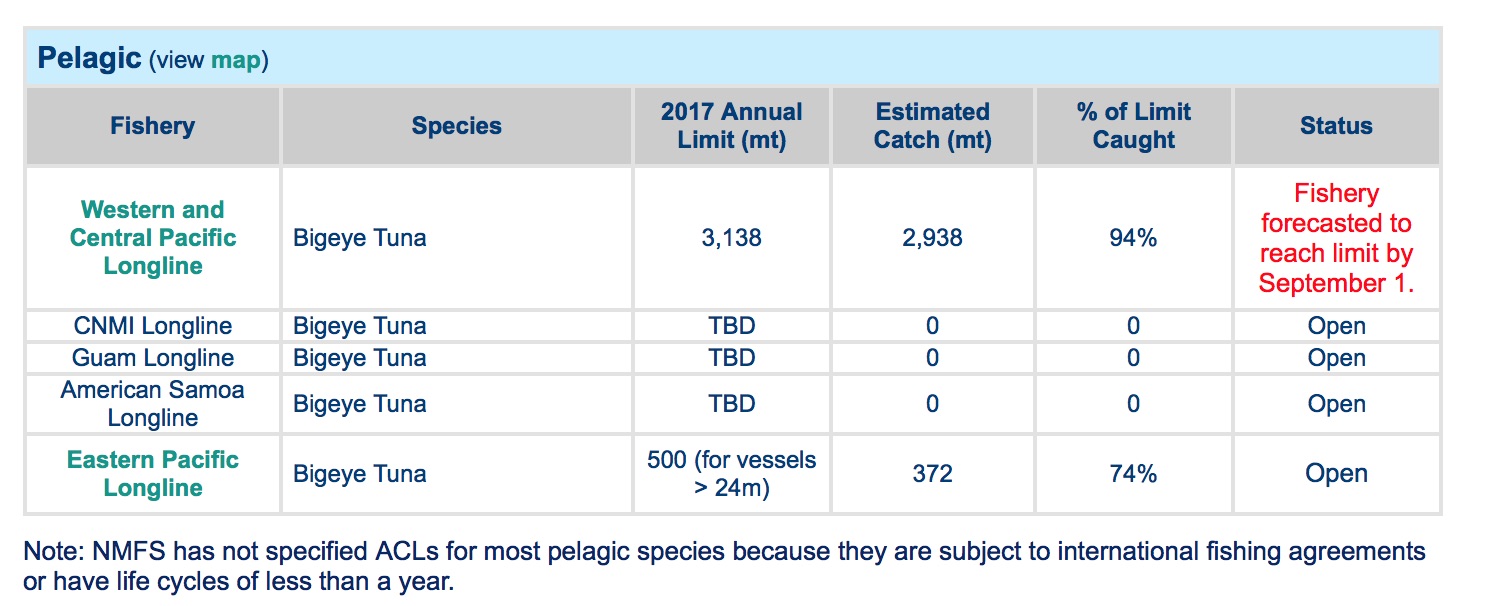 On September 1, the National Marine Fisheries Service is closing the bigeye fishery for most vessels in the the Hawaii longline fleet, with the fleet having exceeded its 2017 limit of 3,138 metric tons for the Western and Central Pacific.
On September 1, the National Marine Fisheries Service is closing the bigeye fishery for most vessels in the the Hawaii longline fleet, with the fleet having exceeded its 2017 limit of 3,138 metric tons for the Western and Central Pacific.
On August 31, NMFS announced that it was setting quotas for each of the U.S. Territories in the Pacific (Guam, American Samoa, and the Commonwealth of the Northern Mariana Islands) at 2,000 metric tons, up to half of which can be allocated to the Hawaii Longline Association (HLA). Those quotas will take effect on September 15, at the end of the period for public comment on the proposed territorial quotas.
“We need to take comments and publish a final rule before any changes are made,” National Marine Fisheries Service Pacific Islands Regional Office administrator Michael Tosatto stated in an email. That means, Hawai`i longliners may not retain any bigeye caught in the Western and Central Pacific after September 1, since no quota transfer arrangements have been reviewed or approved.
“The final rule publication and arrangement approval can happen on the same day, but that date is not known yet,” Tosatto wrote.
The transfer of a portion of the territorial quotas to Hawai`i longliners has been a controversial policy devised by the Hawai`i Longline Association and the Western Pacific Fishery Management Council in 2011 (and since then reported on extensively by Environment Hawai`i).
Although the closure is one in name only, the Federal Register notice goes through the motions of pretending its meaningful:
“NMFS must close the fishery as soon as possible to ensure that the fishery does not exceed the catch limit,” the Federal Register notice states. “According to NMFS stock-status determination criteria, bigeye tuna in the Pacific Ocean are currently experiencing overfishing. NMFS implemented the catch limit to reduce the effects of fishing on bigeye tuna and restore the stock to levels capable of producing maximum sustainable yield on a continuing basis. Failure to close the fishery immediately would result in additional fishing pressure on this stock, in violation of federal law and regulations that implement WCPFC [Western and Central Pacific Fisheries Commission] decisions.”
WCPFC’s tropical tuna Conservation and Management Measure expires at the end of this year. The commission is expected to adopt a new tuna management scheme at its December meeting in the Philippines.
Tosatto said it’s unknown how NMFS will account for this year’s overage when setting next year’s quotas. If WCPFC’s new tropical tuna CMM retains the provision allowing members to subtract overages from the following year’s quota, and United States has proposed that it does, “then it would run like past years,” he said.



Leave a Reply